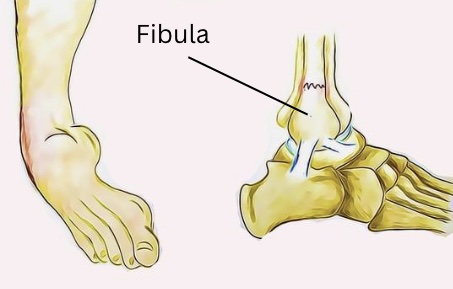CUMBERLAND PHYSIOTHERAPY PARRAMATTA:
What are they?
The lower part of the leg, from the knee down to the ankle, consists of two long bones that sit side by side: the thicker Tibia and the thinner Fibula. The bones are joined together by thick fibrous connective tissue called a “syndesmosis” and are firmly adhered to each other with just a small amount of movement between them, allowing for a small amount of rotation of the ankle.
A fracture of the fibula occurs when the bony tissue is disrupted or broken. It is a common injury and can occur at any part of the bone, depending on the mechanism of injury or the state of the bone.
How does it happen?
A fracture of any bone can occur when the force applied to any point exceeds the strength of the tissue at that point. However, as with all fractures, there are common patterns that are seen based on structural points of weakness in the bone and common patterns of movement. A few common ways that the fibula is broken are;
Blunt force:
If something hits the bone hard enough, it will break on impact. This could include being hit by a ball hard enough or being hit by a car, as this is the site where a car’s bumper would reach. Impacts like this that have enough force will often break both the Tibia and the Fibula at the same time. Skiing accidents where skis hit something suddenly or get stuck can also cause the bones to break at the level of the ski boots.
Ankle Sprain:
When it comes to the fibula, the most common reason for the bone to be broken is during a severe ankle sprain. The ligaments that attach the outside of the foot to the fibula are so strong that when you twist your ankle badly enough, sometimes it is the bone that breaks. This is one of the most commonly missed injuries, partly because the fibula is not a weight-bearing bone. This means that after the initial pain and swelling have subsided, you can still walk on your foot without pain stopping you. It is important to have any severe ankle sprains imaged by X-ray to rule out any fibula fractures.
What are the symptoms?
In some cases, the symptoms of a fibula fracture will be unmistakable, with severe pain. Sometimes the skin will be broken and there will be bleeding. If the bone has been moved from its usual position, there will be a deformity under the skin. For smaller, displaced fractures, there will be pain over the bony aspects and a constant, deep pain that is worse when weight-bearing.
What is the treatment?
Physiotherapists are often the first to notice fractures caused by ankle sprains. Once a fracture has been confirmed, your medical team will decide on the best course of action to allow the bones to heal. This might include surgery to pin the bones together, casting or the use of a moon boot. Following a period of immobilisation, your physiotherapist can help you rehabilitate the surrounding tissues. This will include muscle strengthening, joint mobilisation, balance and control retraining, and a stretching program.
None of the information in this article is a replacement for proper medical advice. Always seek medical professional advice for your condition.

